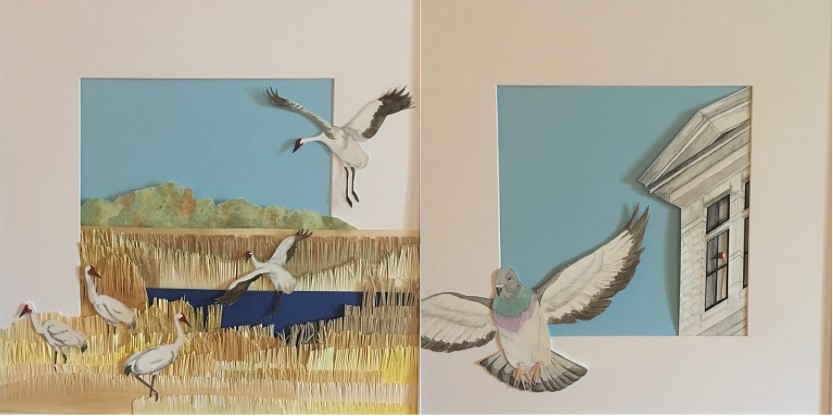Intricacies between instructional design and the creative experience: How do design-based research and research-creation cohabit?
Main Article Content
Abstract
This article highlights the intricacies between the design of pedagogical innovations specific to design-based research and the artistic experience as a method, characteristic of research-creation. The author presents a pilot study in art education and demonstrates how design-based research benefits from the artistic process and from the epistemological orientations of research-creation for the conception and the implementation of an educational design. This entanglement of the artistic process at the heart of design production can thus contribute to the generation of new knowledge, specifically related to the field of art education.
Downloads
Article Details

This work is licensed under a Creative Commons Attribution-ShareAlike 4.0 International License.
The copyright notice is CC BY SA.
This license lets others remix, tweak, and build upon your work even for commercial purposes, as long as they credit you and license their new creations under the identical terms. All new works based on yours will carry the same license. Thus any derivatives will also allow commercial use. For example, if someone translates your article into French, the French version of the article will also have to be shared under a CC BY SA license.
References
Anderson, T.etShattuck, J. (2012). Design-Based Research: A decade of progress ineducation research? Educational Researcher, 41(1), 16-25. https://doi.org/10.3102/0013189X11428813Barone, T. et Eisner, E. W. (2012). Arts based research. SAGE. Barrett, E.et Bolt, B. (2010). Practice as research: Approaches to creative arts enquiry.I.B.Tauris. Brown, A. L. (1992). Design Experiments: Theoretical and methodological challenges increating complex interventions in classroom settings. Journal of the Learning Sciences, 2(2), 141-178. https://doi.org/10.1207/s15327809jls0202_2Castro, J.C. (2007). Enabling artistic inquiry.Canadian Art Teacher, 6(1), 6-16.Chapman, O. et Sawchuk, K. (2012). Research-Creation: Intervention, analysis and familyresemblances. Canadian Journal of Communication, 37(1), 5-26. https://doi.org/10.22230/cjc.2012v37n1a2489Class, B.etSchneider, D. (2013). La Recherche Design enÉducation:Vers une nouvelleapproche?Frantice.net, 7, 5-16.https://archive-ouverte.unige.ch/unige:34459 Ellsworth, E. A. (2005). Places of learning: Media, architecture, pedagogy. Routledge.Falcón, R. M. (2016). La pensée artistique par la recherche sensible. Sociétés, 131(1), 131-139.https://doi.org/10.3917/soc.131.0131Gosselin, P. (2011). Pour un enseignement des arts éclairé par une pratique réflexive de lacréation. Dans P. Gosselin et E. St-Denis (dir.), Résonances:Pour un dialogueentre création et enseignement des arts(pp. 31-57). Guérin.
Gosselin,P., Potvin, G., Gingras, J.-M.etMurphy, S. (1998). Une représentation de ladynamique de création pour le renouvellement des pratiques en éducation artistique. Revue des sciences de l’éducation, 24(3), 647-666. https://doi.org/10.7202/031976arHaseman, B. (2006). Tightrope writing: Creative writing programs in the RQFenvironment. Keynote address forperilous adventures: Creative writing practice in the higher degree and beyond. Eleventh Annual Conference of the Australian Association of Writing Programs. Brisbane, Australia. http://www.textjournal.com.au/april07/haseman.htmIto, M. (dir.).(2010).Hanging out, messing around, and geeking out: Kids living andlearning with new media. MIT Press. Jenkins, H. (2009). Confronting the challenges of participatory culture: Media educationfor the 21st century. MIT Press.Kozel, S. (2013). Dancing with twitter –Mobile narratives become physical scores. DansJ. Farman (dir.),The mobile story: Narrative practices with locative technologies(pp. 79-94). Routledge.Lafortune, J.M. (2012). La médiation culturelle:Le sens des mots et l’essence despratiques.Presses de l’Université du Québec.Levy, P. (2020). Method meets arts: Arts-based research practice(3e éd.).The GuildfordPress. Leavy, P. (2009). Method meets art: Arts-based research practice(1st ed.).The GuilfordPress.Mace, M.A., et Ward, T. (2002). Modeling the creative process: A grounded theoryanalysis of creativity in the Domain of Art Making. Creativity Research Journal, 14(2), 179-192. https://doi.org/10.1207/S15326934CRJ1402_5McKenney, S. et Reeves, T. C. (2019). Conducting educational design research(2e éd.).Routledge.McKenney, S. et Reeves,T. C. (2014). Educational design research. DansJ. M. Spector, M.D. Merrill, J. Elen, etM. J. Bishop (dir.), Handbook of research on educational communications and technology4e éd.,(pp.131-140).Springer.https://doi.org/10.1007/978-1-4614-3185-5_11Nguyen, D. J., et Larson, J. B.(2015). Don’t forget about the body:Exploring the curricularpossibilities of embodied pedagogy. Innovative HigherEducation,40(4), 331-344.Doi: 10.1007/s10755-015-9319-6Paquin, L.C. et Béland, M. (2019). Dialogue autour de la recherche-création.http://www.lcpaquin.com/publi_pdf/Dialogue_autour_de_la_recherche-creation.pdfPaquin, L.C. et Noury, C. (2018). Définir la recherche-création ou cartographier sespratiques?Découvrir magazine ACFAS. https://www.acfas.ca/publications/magazine/2018/02/definir-recherche-creation-cartographier-ses-pratiquesReimann, P. (2011). Design-Based Research. Dans L. Markauskaite, P. Freebody, et J.Irwin (dir.), Methodological choice and design. (Methodos Series. Methodological Prospect in the Social Sciences, vol 9),(pp. 37-50). Springer. Doi:10.1007/978-90-481-8933-5_3Rourke, L.et Friesen, N. (2006). The learning sciences: The very idea. Educational MediaInternational, 43, 271-284.https://www.learntechlib.org/p/166452/.Sanchez, É.etMonod-Ansaldi, R. (2015). Recherche collaborative orientée par laconception. Éducation& didactique, 9(2), 73-94.Doi: https://doi.org/10.4000/educationdidactique.2288Shah, J. K., Ensminger, D. C., etThier, K. (2015). The time for design-based research isrightand right now. Mid-Western Educational Researcher, 27(2), 152-171.Uhls, Y. T., Michikyan, M., Morris, J., Garcia, D., Small, G. W., Zgourou, E. et Greenfield,P. M. (2014). Five days at outdoor education camp without screens improves preteen skills with nonverbal emotion cues. Computers in Human Behavior, 39, 387-392. https://doi.org/10.1016/j.chb.2014.05.036Wang, F.etHannafin, M. J. (2005). Design-based research and technology-enhancedlearning environments. Educational Technology Research and Development, 53(4), 5-23.Zhao, S. et Elesh, D. (2008). Copresence as ‘being with’. Information, Communication &Society, 11(4), 565-583. https://doi.org/10.1080/136911808019989951

